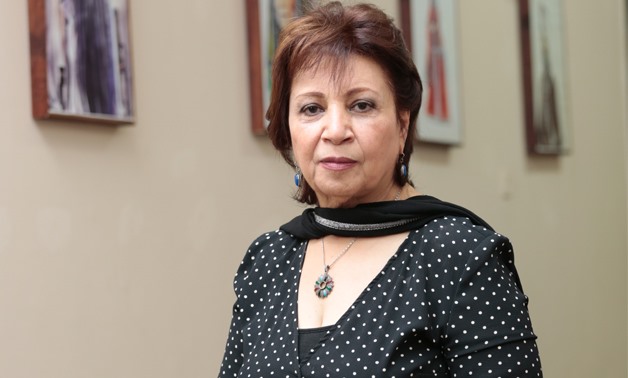
Samia Abd El Aziz - Hayssam Samir/Egypt Today
A costume designer specialized in historical drama, Samia Abd El-Aziz has left her mark on the Egyptian and Arab drama scene. With iconic works that include the Islamic-themed period drama Dawn of Islam (1971, directed by Salah Abou Seif) to the most recent The Sultan and the Shah by acclaimed Jordanian director Mohamed Azizeya, Abd El-Aziz has carved a name for herself as one of the most acclaimed costume designers in Egypt.
Graduating from the costume design department at the High Institute of Cinema in 1967, Abd El-Aziz studied among many renowned contemporary filmmakers including Dawood Abd El-Sayed, Aly Badrakhan and Khairy Beshara. Her leading professor of that era was the late filmmaker Chadi Abdel Salam (1930–1986), director of the two Egyptian classics Al-Mummia (The Night of Counting the Years, 1969) and El-Fallâh el-Fasîh (The Eloquent Peasant, 1970) and art director and costume designer of several historical films like the Polish film Pharaoh (1966) by Jerzy Kawalerowicz and the Egyptian film Saladin the Victorious (1963) by Youssef Chahine.
Upon graduation, Abd El-Aziz worked as assistant designer to Abdel Salam himself in the Islamic-themed historical drama Dawn of Islam. The
following year, she became the costume designer of Al- Shayma: Prophet’s Sister by Houssam El-Din Mustafa. After four years of postgraduate studies in Russia, Abd El-Aziz came back to Egypt during the mid-1970s with her PhD to venture into a career that spanned over more than four decades in period dramas and films.
Customizing the customs
“Researching historical dramas was more difficult in my generation than nowadays,” explained Abd El-Aziz in her office at the High Institute of Cinema where she still teaches. “We used to read tens of books to land a lead about the look of certain eras. We were taught by Abdel Salam to research then to imagine and create. Some eras weren’t documented in images or drawings and we needed to let our imagination and our knowledge be our guides.”
Abd El-Aziz also gives a lot of importance to the impressions she gets from the characters after reading the screenplay during the pre-production phase to retrace its timeline and reflect it in her designs for the character. “Once I finish reading, I start to imagine all the characters coming alive in front of my eyes,” she says. “After scanning all the styles of this certain era, I start to decide what to implement and what to pass on for the series and its characters. I also like to have my own take on my designs and not just copy history completely. The costume of each character along with the hairstyle and make-up must reflect the inner psychological aspect and its interaction with the other characters.”
The latest series Abd El-Aziz worked on is The Sultan and the Shah, taking place in the 16th century and retracing the conflict between Selim I, the Sultan of the Ottoman Empire and Ismail I, the Shah of Iran. In the series, Mohamed Riad plays the Shah and Samer El-Masry. The rest of the cast is made up of Arab actors. “Because of the multitude of the characters in such a production, I design specific characterization for each society in the series,” explains Abd El-Aziz. “There’s the Persian society, the Turkish society and the Arab society and each [has their] own visual characteristic in terms of costumes and set decorations, which should be coordinated with the art director and the director of photography,” she explains. “From a technical point in this specific series, I had to design all the costumes without the green color although it prevails in Persian culture because it was a request from the director who was shooting using a green screen in the background that is necessary for adding visuals using computer graphics depth during the postproduction phase.”
During her career, Abd El-Aziz collaborated with leading television director Mohamed Fadel in more than 10 series and films. Most prominently, the two worked on the black-and-white Nasser 56 where the late Ahmed Zaki played President Gamal Abd El-Nasser. “The challenge in that film was to reflect the period without colors,” says Abd El-Aziz. Fadel got Abd El-Aziz dozens of books and documents from Hoda Abdel-Nasser, the president’s daughter, to facilitate the research. “Because all Egyptians, being contemporaries of Nasser or not, knew about his looks and charisma, it was a great challenge for me and all the filmmakers to bring him back to life on celluloid. On the opposite side, a character like the president’s wife Tahia Kazem, played by Fardous Abd El-Hamid, was difficult to approach because she was not a media regular during that era and so we had very few photos of hers.” This is where Abd El-Aziz had to let her creativity take over, based on the few documents she had.
“I remember Ahmed Zaki was always in character between takes to the extent that he addressed me the way Nasser would have addressed a lady speaking to him,” Abd El-Aziz recalls.






Comments
Leave a Comment